What Can You Do For Iris Plant Material Irritated Skin?
| Iris | |
|---|---|
 | |
| Iris sibirica | |
| Scientific classification | |
| Kingdom: | Plantae |
| Clade: | Tracheophytes |
| Clade: | Angiosperms |
| Clade: | Monocots |
| Order: | Asparagales |
| Family: | Iridaceae |
| Subfamily: | Iridoideae |
| Tribe: | Irideae |
| Genus: | Iris L., 1753 |
| Type species | |
| Iris germanica L. | |
| Subgenera | |
| Hermodactyloides | |
| Synonyms | |
| Belamcanda | |
Iris is a genus of 260–300[1] [2] species of flowering plants with showy flowers. It takes its proper name from the Greek word for a rainbow, which is also the name for the Greek goddess of the rainbow, Iris. Some authors state that the name refers to the wide variety of flower colors plant among the many species.[3] As well as being the scientific name, iris is also widely used as a common name for all Iris species, every bit well as some belonging to other closely related genera. A mutual proper name for some species is 'flags', while the plants of the subgenus Scorpiris are widely known as 'junos', specially in horticulture. It is a popular garden flower.
The often-segregated, monotypic genera Belamcanda (blackberry lily, I. domestica), Hermodactylus (snake's head iris, I. tuberosa), and Pardanthopsis (vesper iris, I. dichotoma) are currently included in Iris.
3 Iris varieties are used in the Iris blossom data set outlined by Ronald Fisher in his 1936 paper The employ of multiple measurements in taxonomic problems every bit an example of linear discriminant analysis.[4]
Clarification [edit]
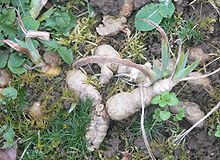
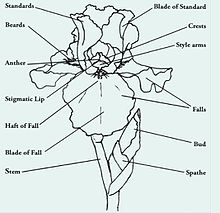
Analogy of an iris flower with highlighted parts of the flower
Irises are perennial plants, growing from creeping rhizomes (rhizomatous irises) or, in drier climates, from bulbs (bulbous irises). They accept long, erect flowering stems which may exist simple or branched, solid or hollow, and flattened or accept a circular cross-section. The rhizomatous species unremarkably have iii–10 basal sword-shaped leaves growing in dense clumps. The bulbous species accept cylindrical, basal leaves.[ citation needed ]
Bloom [edit]
The inflorescences are in the shape of a fan and contain one or more symmetrical half-dozen-lobed flowers. These grow on a pedicel or peduncle. The three sepals,[5] which are usually spreading or droop down, are referred to equally "falls". They aggrandize from their narrow base of operations (the "hook" or "haft"[half-dozen]), into a broader expanded portion ("limb" or "blade"[vii]) and can be adorned with veining, lines or dots. In the centre of the blade, some of the rhizomatous irises have a "bristles", a row of fuzzy hairs at the base of operations of each falls petal which gives pollinators a landing place and guides them to the nectar.[8]
The 3,[5] sometimes reduced, petals stand upright, partly backside the sepal bases. They are called "standards". Some smaller iris species have all six lobes pointing straight outwards, merely generally limb and standards differ markedly in appearance. They are united at their base of operations into a floral tube that lies above the ovary (known every bit an epigynous or junior ovary). The iii styles[5] dissever towards the apex into petaloid branches; this is significant in pollination.[ citation needed ]
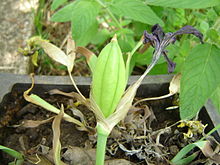
The iris flower is of involvement equally an example of the relation between flowering plants and pollinating insects. The shape of the flower and the position of the pollen-receiving and stigmatic surfaces on the outer petals form a landing-stage for a flight insect, which in probing for nectar, will beginning come up into contact with the perianth, then with the iii[5] stigmatic stamens in ane whorled surface which is borne on an ovary formed of three carpels. The shelf-like transverse project on the inner whorled underside of the stamens is beneath the overarching style arm below the stigma, so that the insect comes in contact with its pollen-covered surface only subsequently passing the stigma; in bankroll out of the flower information technology will come up in contact only with the non-receptive lower face up of the stigma. Thus, an insect bearing pollen from i flower volition, in entering a second, deposit the pollen on the stigma; in backing out of a flower, the pollen which it bears will not be rubbed off on the stigma of the aforementioned blossom.[ix]
The iris fruit is a capsule which opens up in 3 parts to reveal the numerous seeds inside. In some species, the seeds bear an aril. Such as Iris stolonifera which as light dark-brown seeds that have thick white aril (or coatings).[10]
Taxonomy [edit]
Iris is the largest genus of the family Iridaceae with up to 300 species – many of them natural hybrids.[11] Modern classifications, starting with Dykes (1913), take subdivided them. Dykes referred to the major subgroupings every bit sections. Subsequent authors such as Lawrence (1953) and Rodionenko (1987) have generally called them subgenera, while substantially retaining Dykes' groupings, using six subgenera further divided into twelve sections. Of these, section Limneris (subgenus Limneris) was further divided into sixteen series. Like some older sources, Rodionenko moved some of the bulbous subgenera (Xiphium, Scorpiris and Hermodactyloides) into separate genera (Xiphion, Juno and Iridodictyum respectively), only this has not been accepted by later writers such as Mathew (1989), although the latter kept Hermodactylus as a distinct genus, to include Hermodactylus tuberosus, now returned to Hermodactyloides every bit Iris tuberosa.[11]
Rodionenko likewise reduced the number of sections in subgenus Iris, from six to ii, depending on the presence (Hexapogon) or absence (Iris) of arils on the seeds, referred to as arilate or nonarilate. Taylor (1976) provides arguments for non including all arilate species in Hexapogon.[11]
In general, mod classifications usually recognise half-dozen subgenera, of which five are restricted to the Old World; the sixth (subgenus Limniris) has a Holarctic distribution. The 2 largest subgenera are further divided into sections. The Iris subgenus has been divided into six sections; bearded irises (or pogon irises), Psammiris, Oncocyclus, Regelia, Hexapogon and Pseudoregelia.[12] Iris subg. Limniris has been divided into ii sections; Lophiris (or 'Evansias' or crested iris) and Limniris which was further divided into xvi series.[13]
Development [edit]
The concept of introgressive hybridization (or "introgression") was kickoff invented to draw the pattern of interspecific hybridization followed by backcrossing to the parentals that is common in this genus.[14]
Subgeneric division [edit]
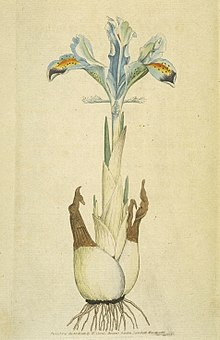
A member of subgenus Scorpiris: Iris persica, a bulbous iris
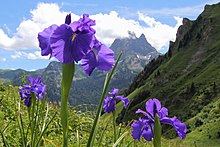
Subgenera [edit]
- Iris (Bearded rhizomatous irises)
- Limniris (Beardless rhizomatous irises)
- Xiphium (Shine-bulbed bulbous irises: Formerly genus Xiphion)
- Nepalensis (Bulbous irises: Formerly genus Junopsis)
- Scorpiris (Smooth-bulbed bulbous irises: Formerly genus Juno)
- Hermodactyloides (Reticulate-bulbed bulbous irises: Formerly genus Iridodictyum)
Sections, series and species [edit]
Distribution and habitat [edit]
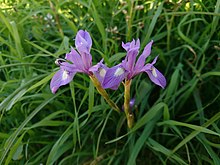

Nearly all species are found in temperate Northern Hemisphere zones, from Europe to Asia and across North America. Although diverse in ecology, Iris is predominantly found in dry, semi-desert, or colder rocky mountainous areas.[eleven] Other habitats include grassy slopes, meadowlands, bogs and riverbanks.[ commendation needed ]
Cultivation [edit]

Iris is extensively grown as ornamental plant in abode and botanical gardens. Presby Memorial Iris Gardens in New Bailiwick of jersey, for example, is a living iris museum with over 10,000 plants, while in Europe the most famous iris garden is arguably the Giardino dell'Iris in Florence (Italian republic) which every twelvemonth hosts a well attended iris breeders' competition. Irises, particularly the multitude of bearded types, characteristic regularly in shows such as the Chelsea Flower Evidence.
For garden tillage, iris nomenclature differs from taxonomic classification. Garden iris are classed equally either bulb iris or rhizome iris (called rhizomatous) with a number of further subdivisions. Due to a wide variety of geographic origins, and thus slap-up genetic diversity, cultivation needs of iris vary profoundly.
Iris grow well in most whatsoever garden soil types providing they are well-tuckered. The primeval to flower are species similar I. junonia and I. reichenbachii, which blossom every bit early as Feb and March in the Northern Hemisphere, followed by the dwarf forms of I. pumila, and then by most of the alpine bearded varieties, such as the German iris and its multifariousness florentina, sweet iris, Hungarian iris, lemon-yellow iris (I. flavescens), Iris sambucina, I. amoena, and their natural and horticultural hybrids such equally those described under names like I. neglecta or I. squalens and all-time united under I. × lurida.
The iris is promoted in the Great britain by the British Iris Society.[fifteen] The national collection of Arthur Bliss Irises is held in Gloucestershire.[16]
Bearded rhizome iris [edit]

'Amethyst Flame'. Annotation prominent "bristles".
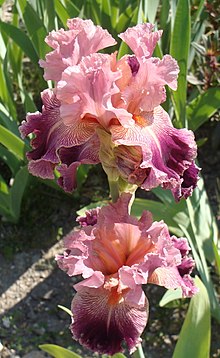
Tall Bearded Iris 'Barocco'
Bearded iris are classified as dwarf, tall, or aril. In Europe, the nearly usually institute garden iris is a hybrid iris (falsely called German iris, I. germanica which is sterile) and its numerous cultivars. Various wild forms (including Iris aphylla)[17] and naturally occurring hybrids of the Sweet iris (I. pallida) and the Hungarian iris (I. variegata) course the basis of nearly all modernistic hybrid bearded irises. Median forms of bearded iris (intermediate bearded, or IB; miniature tall disguised, or MTB; etc.) are derived from crosses between tall and dwarf species similar Iris pumila.
The "bristles", brusk hairs arranged to look like a long furry caterpillar, is found toward the dorsum of the lower petals and its purpose is to guide pollinating insects toward the reproductive parts of the constitute. Bearded irises have been cultivated to have much larger blooms than historically; the flowers are now twice the size of those a hundred years agone. Ruffles were introduced in the 1960s to aid stabilize the larger petals.[eighteen]
Disguised iris are like shooting fish in a barrel to cultivate and propagate and have get very popular in gardens. A minor selection is commonly held by garden centres at appropriate times during the flavor, merely there are thousands of cultivars available from specialist suppliers (more than than 30,000 cultivars of tall disguised iris). They are best planted every bit blank root plants in late summer, in a sunny open up position with the rhizome visible on the surface of the soil and facing the sun. They should be divided in summer every ii or 3 years, when the clumps go congested.
A truly red bearded iris, like a truly bluish rose, remains an unattained goal despite frequent hybridizing and pick.[19] There are species and selections, most notably based on the beardless rhizomatous Copper iris (I. fulva), which accept a relatively pure cherry colour. Even so, getting this color into a mod disguised iris breed has proven very difficult, and thus, the vast majority of irises are in the imperial and blue range of the color spectrum, with yellowish, pinkish, orange and white breeds also available. Irises – like many related genera – lack cherry-based hues because their anthocyanins are delphinidin-derived.[twenty] Pelargonidin-derived anthocyanins would lend the sought-after blueish-based colors but these genera are metabolically disinclined to produce pelargonidin.[20] Dihydroflavonol 4-reductases in Iris 's relatives selectively practise non catalyse dihydrokaempferol to leucopelargonidin, the precursor, and this is probably the case here besides.[20] The other metabolic difficulty is the presence of flavonoid iii'-hydroxylase, which in Chrysanthemum inhibits pelargonidin synthesis.[20] The bias in irises towards delphinidin-anthocyanins is so pronounced that they have served as the gene donors for transgenic attempts at the same blueish roses.[20] Although these have been technically successful – over 99% of their anthocyanins are blue – their growth is bedridden and they take never been commercializable.[20]
AGM cultivars [edit]
The following is a selection of bearded irises that have gained the Royal Horticultural Society's Award of Garden Merit:
- 'Alizes'[21] (tall bearded, bluish & white)
- 'Bumblebee Deelite'[22] (miniature alpine bearded, yellowish/purple)
- 'Early Light'[23] (tall disguised, stake xanthous)
- 'Jane Phillips'[24] (tall bearded, pale blue)
- 'Langport Wren'[25] (intermediate disguised, maroon)
- 'Maui Moonlight'[26] (intermediate bearded, pale xanthous)
- 'Orinoco Flow'[27] (border disguised, white/violet)
- 'Raspberry Blush'[28] (intermediate bearded, pink)
- 'Sarah Taylor'[29] (dwarf disguised, stake yellow)
- 'Thornbird'[30] (tall disguised, stake yellow)
- 'Titan'south Glory'[31] (tall bearded, deep blue)
Disguised iris Oncocyclus department [edit]
This department contains the cushion irises or royal irises, a group of plants noted for their big, strongly marked flowers. Betwixt 30 and lx species are classified in this section, depending on the say-so. Species of section Oncocyclus are generally strict endemics, typically occurring in a pocket-size number of scattered, disjunct populations, whose geographical isolation is enhanced past their pollination strategy and myrmecochory seed dispersal. Morphological divergence betwixt populations usually follows a cline reflecting local adaptation to environment conditions; furthermore, this largely overlaps divergence between species, making it difficult to identify discrete species boundaries in these irises.[32] [33] Compared with other irises the absorber varieties are scantily furnished with narrow sickle-shaped leaves and the flowers are commonly borne singly on the stalks; they are often very dark and in some well-nigh blackish.[34] The cushion irises are somewhat fastidious growers, and to be successful with them they must be planted rather shallow in very gritty well-drained soil. They should not be disturbed in the autumn, and subsequently the leaves have withered the roots should exist protected from heavy rains until growth starts again naturally.
Disguised iris Regelia department [edit]
This section, closely centrolineal to the cushion irises, includes several garden hybrids with species in section Oncocyclus, known every bit Regelio-cyclus irises. They are best planted in September or October in warm sunny positions, the rhizomes beingness lifted the post-obit July after the leaves have withered.
Beardless rhizome iris (subgenus Limniris) [edit]
There are six major subgroupings of the beardless iris, depending on origin. They are divided into Pacific Coast, Siberica, Spuria, Louisiana, Japanese, and other.
Beardless rhizomatous iris types unremarkably found in the European garden are the Siberian iris (I. sibirica) and its hybrids, and the Japanese Iris (I. ensata) and its hybrids. "Japanese iris" is too a grab-all term for the Japanese iris proper (hanashōbu), the claret iris (I. sanguinea, ayame) and the rabbit-ear iris (I. laevigata, kakitsubata). I. unguicularis is a late-winter-flowering species from Algeria, with heaven-blueish flowers with a yellowish streak in the centre of each petal, produced from Winter to Spring. Yet another beardless rhizomatous iris popular in gardening is I. ruthenica, which has much the same requirements and characteristics as the tall bearded irises. In N America, Louisiana iris and its hybrids are often cultivated.
Crested rhizome iris (subgenus Limniris) [edit]
One specific species, Iris cristata from North America.
Bulbing juno iris (subgenus Scorpiris) [edit]
Often chosen 'junos', this type of iris is one of the more than popular bulb irises in cultivation. They are generally earliest to bloom.
Bulbing European iris (subgenus Xiphium) [edit]
This group includes irises generally of European descent, and are too classified as Dutch, English, or Spanish iris.
- Iris reticulata and Iris persica, both of which are fragrant, are also popular with florists.
- Iris xiphium, the Castilian Iris (too known as Dutch Iris) and
- Iris latifolia, the English Iris. Despite the common names both the Spanish and English iris are of Spanish origin, and have very showy flowers, so they are pop with gardeners and florists. They are among the hardier bulbous irises, and can exist grown in northern Europe. They require to be planted in thoroughly tuckered beds in very calorie-free open soil, moderately enriched, and should have a rather sheltered position. Both these present a long series of beautiful varieties of the most diverse colours, flowering in May, June and July, the smaller Spanish iris being the before of the two.
Bulbing reticulate iris (subgenus Hermodactyloides) [edit]
Reticulate irises with their characteristic bulbs, including the yellow I. danfordiae, and the various blueish-purple I. histrioides and I. reticulata, flower equally early on as February and March. These reticulate-bulbed irises are miniatures and popular bound bulbs, existence i of the beginning to blossom in the garden. Many of the smaller species of bulbous iris, being liable to perish from excess of moisture, should take a well-drained bed of good but porous soil fabricated up for them, in some sunny spot, and in winter should exist protected by a covering of one-half-rust-covered leaves or fresh coco-fiber.
Gallery [edit]
-
-

Bearded iris cultivar, like to the classic/historical cultivar 'Alcazar'
-

Chestnut iris cultivars like 'Samurai Warrior' are the closest that breeders have been able to attain to a red bearded iris
-

-

Iris 'Katharine Hodginkin', a bulbous cultivar existence a hybrid of I. winogradowii and I. histrioides 'Major'
-

-

-

-

Iris ensata 'Bluish Dazzler'
-
Iris 'Queen of Angels'
-
Iris 'Blatant'
-

Iris germanica, an old and vigorous cultivar that requires minimal culture
-

Iris 'Mrs. Andris', a vigorous, historic, tall bearded iris cultivar that Fryer hybridized in 1919
-

-

Uses [edit]
Aromatic rhizomes [edit]

Bombay Sapphire gin contains flavoring derived from particular bearded iris species Iris germanica and Iris pallida.
Rhizomes of the High german iris (I. germanica) and sweetness iris (I. pallida) are traded as orris root and are used in perfume and medicine, though more common in ancient times than today. Today Iris essential oil (absolute) from flowers are sometimes used in aromatherapy as sedative medicines. The stale rhizomes are also given whole to babies to help in teething. Gin brands such as Mumbai Sapphire and Magellan Gin use orris root and sometimes iris flowers for flavor and color.[35] [36]
For orris root production, iris rhizomes are harvested, dried, and anile for up to 5 years. In this time, the fats and oils inside the roots undergo degradation and oxidation, which produces many fragrant compounds that are valuable in perfumery. The scent is said to be like to violets. The aged rhizomes are steam-distilled which produces a thick oily compound, known in the perfume industry as "iris butter" or orris oil.[37]
Iris rhizomes as well contain notable amounts of terpenes, and organic acids such equally ascorbic acid, myristic acrid, tridecylenic acrid and undecylenic acid. Iris rhizomes can be toxic. Larger blue flag (I. versicolor) and other species oftentimes grown in gardens and widely hybridized contain elevated amounts of the toxic glycoside iridin. These rhizomes can cause nausea, airsickness, diarrhea, and/or skin irritation, but poisonings are not normally fatal. Irises should only exist used medicinally nether professional guidance.[38]
Water purification [edit]
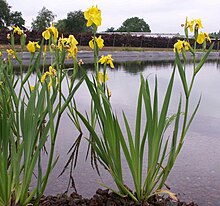
In h2o purification, xanthous iris (I. pseudacorus) is oftentimes used. The roots are usually planted in a substrate (e.g. lava-stone) in a reedbed-setup. The roots then ameliorate water quality by consuming food pollutants, such as from agronomical runoff. This highly aggressive grower is now considered a noxious weed and prohibited in some states of the The states where information technology is found clogging natural waterways.[39]
In civilization [edit]
The Iris is one of the flowers listed as nascency flower for February.[40] In Christianity, the iris represents Our Lady of Sorrows as its sharp leaves are like swords.[41]
The Iris croatica is the unofficial National Flower of Croatia.[42] Iris nigricans, the black iris is the national bloom of Jordan.[43] Iris bismarckiana, the Nazareth Iris, is the symbol of the city of Upper Nazareth.[44] [45]
In 1998, Iris lacustris, the Dwarf Lake iris was designated the land wildflower of Michigan,[46] [47] where the vast bulk of populations exist.[48]
In 1990, the Louisiana iris was voted the country wildflower of Louisiana,[49] though the state flower is the magnolia blossom.[50]
In Iran and Kashmir,[51] Iris kashmiriana and Iris germanica [52] are well-nigh commonly grown on Muslim[xiii] grave yards.[53] [17] [54]
An iris — species unspecified — is ane of the state flowers of Tennessee. It is more often than not accepted that the species Iris versicolor, the Majestic Iris is the land flower[55] alongside the wild-growing majestic passionflower (Passiflora incarnata), the country'south other floral emblem. Greeneville, Tennessee, is dwelling house to the annual Iris Festival celebrating the iris, local customs, and civilisation.[56] The species Iris versicolor is also the provincial blossom of Quebec, having replaced the Madonna lily which is not native to the province.[57] and information technology is the official flower of Kappa Pi International Honorary Art Fraternity.[58]
The artist George Gessert has specialised in breeding irises.[59]

The artist Vincent van Gogh painted several famous pictures of irises.[60]
The American artist Joseph Bricklayer – a friend of John James Audubon – painted a precise prototype of what was then known every bit the Louisiana flag or copper iris (Iris fulva), to which Audubon subsequently added 2 Northern paraula birds (Parula americana) for inclusion as Plate 15 in his Birds of America.
The artist Philip Hermogenes Calderon painted an iris in his 1856 work Broken Vows; he followed the principles of the Pre-Raphaelite Brotherhood. An ancient belief is that the iris serves as a warning to be heeded, equally it was named for the messenger of Olympus. It also conveys images of lost dearest and silent grief, for young girls were led into the afterlife by Iris. Broken Vows was accompanied with poetry by Henry Wadsworth Longfellow when it was get-go exhibited.[61]
French King Clovis I (466–511), when he converted to Christianity, inverse his symbol on his banner from three toads to irises (the Virgin's flower).[62]
The fleur-de-lis, a stylized iris, kickoff occurs in its modern employ every bit the emblem of the House of Capet. The fleur-de-lis has been associated with French republic since Louis VII adopted it every bit a symbol in the 12th century. The yellow fleur-de-lis reflects the yellow iris (I. pseudacorus), mutual in Western Europe. Contemporary uses can be seen in the Quebec flag and the logo of the New Orleans Saints professional person football game squad and on the flag of Saint Louis, Missouri.
The red fleur-de-lis in the coat-of-artillery and flag of Florence, Italian republic, descends from the white iris which is native to Florence and which grew fifty-fifty in its city walls. This white iris displayed confronting a red background was the symbol of Florence until the Medici family reversed the colors to betoken a change in political power, setting in move a centuries-long and still on-going breeding programme to hybridize a red iris.
The fleur-de-lis is the nearly-universal symbol of Scouting and one of the symbols adopted by the sorority Kappa Kappa Gamma.
A stylized yellow iris is the symbol of Brussels, since historically the important Saint Gaugericus Island was carpeted in them.[63] The iris symbol is at present the sole characteristic on the flag of the Brussels-Uppercase Region. The provincial flower of Québec (Canada) is the harlequin blueflag (I. versicolor), called iris versicolore in French.
It is thought in China, that Iris anguifuga has the ability to go on snakes from entering the garden. It grows all winter, keeping snakes out, but and so goes dormant in the bound, allowing the snakes back into the garden. In the autumn, the iris re-appears and can finish the snakes once more.[64] [65]
In the Homeric Hymn to Demeter, the goddess Persephone and her companion nymphs (the Oceanids along with Artemis and Athena) were gathering flowers such as rose, crocus, violet, iris (also called 'agallis' or ἀγαλλίς (in Greek script),[66] lily, larkspur,[67] and hyacinth[68] in a springtime meadow before she was abducted by the god Hades.[67]
It has been suggested that the 'agallis' mentioned was a dwarf iris, equally described by foliage and root shape,[69]) and identified as Iris attica.[seventy] [71]
Diseases [edit]
Narcissus mosaic virus is virtually commonly known from Narcissus.[72] [73] Wylie et al., 2014[73] brand the first identification of Narcissus mosaic virus infecting this genus, and the first in Australia.[72] Japanese iris necrotic band virus usually infects this genus.[74] Information technology was, however, unknown in Commonwealth of australia until Wylie et al., 2012[74] identified information technology here in I. ensata.[72]
Gallery [edit]
-

Coat-of-arms of Florence
-

-

-

Stylized Lily used in heraldry
Come across also [edit]
- American Iris Lodge
- Banshu Yamasaki Iris Garden
References [edit]
- ^ "WCSP: Iris". World Checklist of Selected Plant Families . Retrieved two June 2014.
- ^ "Iris". Pacific Bulb Society. 2011-11-26. Retrieved 2012-03-03 .
- ^ Manning, John; Goldblatt, Peter (2008). The Iris Family: Natural History & Classification. Portland, Oregon: Timber Press. pp. 200–204. ISBN978-0-88192-897-6.
- ^ R. A. Fisher (1936). "The use of multiple measurements in taxonomic issues" (PDF). Annals of Eugenics. seven (ii): 179–188. doi:ten.1111/j.1469-1809.1936.tb02137.10. hdl:2440/15227. Archived from the original (PDF) on 2011-04-12. Retrieved 2015-08-30 .
- ^ a b c d Taylor, Ronald J. (1994) [1992]. Sagebrush Country: A Wildflower Sanctuary (rev. ed.). Missoula, MT: Mountain Press Pub. Co. p. 72. ISBN0-87842-280-3. OCLC 25708726.
- ^ "Parts of an Iris Blossom". merlebleu. Archived from the original on 2016-03-04. Retrieved 28 August 2015.
- ^ Donald Wyman Wyman's Gardening Encyclopedia, p. 574, at Google Books
- ^ Growing Beautiful Bearded Iris by Dr. Leonard Perry, Academy of Vermont
- ^ Pat Willmer Pollination and Floral Environmental, p. 78, at Google Books
- ^ Simonet, Marc; Werckmeister, Peter (25 January 1965). "A Cytogenetic and Descriptive Report of the Trispecific Iris Hybrid 'Stolorine' Werckmeister". Caryologia. eighteen (2): 291–303. doi:ten.1080/00087114.1965.10796173.
- ^ a b c d Rina Kamenetsky; Hiroshi Okubo, eds. (2012). "Iridaceae". Ornamental Geophytes: From Basic Science to Sustainable Production. CRC Press. p. 24. ISBN978-1-4398-4924-viii.
- ^ "The Genus Iris". mathcs.clarku.edu . Retrieved 29 July 2021.
- ^ a b Stebbings, Geoff (1997). The Gardener's Guide to Growing Irises . Newton Abbot: David and Charles. p. 23. ISBN978-0715305393.
- ^ Soltis, Pamela S.; Soltis, Douglas E. (2009-06-01). "The Function of Hybridization in Constitute Speciation". Almanac Review of Institute Biological science. Annual Reviews. 60 (1): 561–588. doi:10.1146/annurev.arplant.043008.092039. ISSN 1543-5008. PMID 19575590.
- ^ https://www.britishirissociety.org.united kingdom/
- ^ https://world wide web.blissiris.co.u.k./
- ^ a b Austin, Claire (2005). Irises; A Garden Encyclopedia. Timber Press. ISBN978-0881927306.
- ^ Iris: The classic bearded varieties by Claire Austin, 2001 ISBN 0-670-03034-1
- ^ Graeme Grosvenor (1997). Iris: Flower of the Rainbow. p. 82. ISBN0-86417-777-i.
Blood-red in the sense that nosotros think of it as pillar box or burn down engine red is a color that is not, as however, institute in iris. There are quite a lot of iris which are loosely described as red but it is a class which, in general, has lacked vigour, been difficult to increase and deport over and particularly hard to grow in milder climates.
- ^ a b c d east f Tanaka, Yoshikazu; Brugliera, Filippa (2013-02-19). "Blossom colour and cytochromes P450". Philosophical Transactions of the Purple Social club B: Biological Sciences. The Purple Society. 368 (1612): 20120432. doi:10.1098/rstb.2012.0432. ISSN 0962-8436. PMC3538422. PMID 23297355.
- ^ "RHS Plant Selector – Iris 'Alizes'". Purple Horticultural Lodge. Retrieved 22 September 2020.
- ^ "RHS Found Selector – Iris 'Bumblebee Deelite'". Royal Horticultural Society. Retrieved 22 September 2020.
- ^ "RHS Plant Selector – Iris 'Early Light'". Royal Horticultural Society. Retrieved 22 September 2020.
- ^ "RHS Plant Selector – Iris 'Jane Phillips'". Regal Horticultural Society. Retrieved 22 September 2020.
- ^ "RHS Plant Selector – Iris 'Langport Wren'". Royal Horticultural Guild. Retrieved 22 September 2020.
- ^ "RHS Establish Selector – Iris 'Maui Moonlight'". Royal Horticultural Society. Retrieved 22 September 2020.
- ^ "RHS Plant Selector – Iris 'Orinoco Menstruum'". Royal Horticultural Society. Retrieved 22 September 2020.
- ^ "RHS Plant Selector – Iris 'Raspberry Blush'". Purple Horticultural Society. Retrieved 22 September 2020.
- ^ "RHS Plant Selector – Iris 'Sarah Taylor'". Regal Horticultural Society. Retrieved 22 September 2020.
- ^ "RHS Plant Selector – Iris 'Thornbird'". Royal Horticultural Guild. Retrieved 22 September 2020.
- ^ "RHS Plant Selector – Iris 'Titan's Celebrity'". Purple Horticultural Order. Retrieved 22 September 2020.
- ^ Sapir, Y.; Shmida, A. Species concepts and ecogeographical divergence of Oncocyclus irises. State of israel J. Institute Sci. 2002, l, 119–127
- ^ Abdel Samad, N.; Bou Dagher-Kharrat, M.; Hidalgo, O.; El Zein, R.; Douaihy, B.; Siljak-Yakovlev, S. Unlocking the karyological and cytogenetic diversity of Iris from Lebanon: Oncocyclus section shows a distinctive profile and relative stasis during its continental radiation. PLOS ONE 2016, 15, 11:e0160816. DOI 10.1371/periodical.pone.0160816
- ^ Wilson, Ballad A.; Padiernos, Justin; Sapir, Yuval (Feb 2016). "The royal irises (Iris subg. Iris sect. Oncocyclus): Plastid and low-re-create nuclear information contribute to an understanding of their phylogenetic relationships". Taxon. 65 (1): 35–46. doi:ten.12705/651.three. Retrieved 4 January 2018.
- ^ Kathi Keville The Aromatherapy Garden: Growing Fragrant Plants for Happiness and Well-Being, p. 397, at Google Books
- ^ "Magellan Gin". theginisin.com. 2011-01-29. Retrieved 29 May 2018.
- ^ "Iris L., 1753". www.gbif.org . Retrieved 2022-05-09 .
- ^ David G. Spoerke and Susan C. Smolinske Toxicity of Houseplants, p. 236, at Google Books
- ^ "Yellow Flag Iris". Western New York PRISM. 2014-02-12. Retrieved 2022-05-18 .
- ^ "Birth Month Flower of February - The Iris". 1st in Flowers!.
- ^ Kostka, Arun Oswin. "Flowers in Christian Symbolism".
- ^ James Minahan The Complete Guide to National Symbols and Emblems (2 Volumes), p. 364, at Google Books
- ^ "Wild fauna and Vegetation". kinghussein.gov.jo. Authorities of Jordan. Retrieved 2015-05-10 .
- ^ Rinat, Zafrir (11 September 2006). "Caution, Iris Alee!". haaretz.com. Retrieved 25 July 2016.
- ^ Alon TalAll the Trees of the Forest: State of israel's Woodlands from the Bible to the Present, p. 260, at Google Books
- ^ "Iris lacustris Nutt". michiganflora.net. Archived from the original on 5 March 2016. Retrieved 9 April 2015.
- ^ "Michigan Country Wildflower". Netstate.com. Retrieved 2012-05-14 .
- ^ "Michigan Natural Features Inventory" (PDF). Archived from the original (PDF) on 2011-09-29. Retrieved 2012-05-14 .
- ^ Charlotte Seidenberg (1 March 1993). The New Orleans Garden: Gardening in the Gulf S. Univ. Press of Mississippi. p. 223. ISBN978-0-87805-637-8.
- ^ "Louisiana State Wildflower". statesymbolsusa.org. Retrieved 28 Nov 2014.
- ^ "Chapter I Rhizomatous Iris (part two)". irisbotanique.over-web log.com. Retrieved xx October 2015.
- ^ Singh, Gurcharan. "Kashmir Iris". flowersofindia.net. Retrieved 22 October 2015.
- ^ British Iris Society (1997) A Guide to Species Irises: Their Identification and Tillage, p. 38-39, at Google Books
- ^ Trak, Touseef Hussain; Upadhayay, Ravi (April 2015). "Ethnobotanical And Taxonomic Study Of Members of Iridaceae Family of Kishtwar, (Jammu And Kashmir) Bharat" (PDF). International Journal of Pharma and Bio Sciences. 6 (two): 779–793. Archived from the original (PDF) on 2016-08-02. Retrieved 22 October 2015.
- ^ "Country of Tennessee". land.tn.us.
- ^ "18th Almanac Iris Festival". Greenecountypartnership.com. Archived from the original on 2012-03-15. Retrieved 2012-03-03 .
- ^ (in French) Gouvernement du Québec Emblèmes du Québec - Iris versicolor Archived 2015-07-21 at the Wayback Auto
- ^ Article I, Department 2. "International Constitution of Kappa Pi" (PDF). Kappa Pi International Honorary Art Fraternity Inc. [ permanent expressionless link ] [ round reference ]
- ^ Westward [2008]
- ^ Pioch (2002)
- ^ Mancoff (2003): pp. half dozen, 16
- ^ Margaret Grieve A Modern Herbal, Volume 2 (1971), p. 435, at Google Books
- ^ Chancery of the Prime Government minister, Kingdom of Kingdom of belgium [2007]
- ^ "Species and Water Garden Iris". iriscitygardens.com. Retrieved 19 Jan 2015.
- ^ Kramb, D. (fourteen September 2004). "Iris anguifuga". signa.org (Species Iris Grouping of Due north America). Retrieved xix Jan 2015.
- ^ "ἀγαλλίς". lsj.translatum.gr. Retrieved 10 September 2015.
- ^ a b "Flora 1, Plants of Greek Myth". theoi.com. Retrieved 9 September 2015.
- ^ R. P. Winnington-Ingram Sophocles: An Interpretation (1980), p. 116, at Google Books
- ^ Leonhard Schmitz (Editor) The Classical Museum: A Periodical of Philology, and of Aboriginal History and literature, Volume v (1848), p. 60, at Google Books
- ^ "Tag Archives: British Iris Society". wiebkerost.com. Retrieved 10 September 2015.
- ^ Umberto Quattrocchi CRC Globe Lexicon of Medicinal and Poisonous Plants: Mutual Names, Scientific names, Synonyms and Etymology (2012, p. 128, at Google Books
- ^ a b c Wu, Qingfa; Ding, Shou-Wei; Zhang, Yongjiang; Zhu, Shuifang (2015-08-04). "Identification of Viruses and Viroids by Next-Generation Sequencing and Homology-Dependent and Homology-Contained Algorithms". Annual Review of Phytopathology. Annual Reviews. 53 (1): 425–444. doi:ten.1146/annurev-phyto-080614-120030. ISSN 0066-4286. PMID 26047558. S2CID 20506838.
- ^ a b Wylie, Stephen J.; Li, Hua; Liu, Jiani; Jones, Michael G. G. (2014-04-18). "First report of Narcissus mosaic virus from Australia and from Iris". Australasian Establish Disease Notes. Australasian Plant Pathology Society (Springer). ix (1): i–2. doi:x.1007/s13314-014-0134-1. ISSN 1833-928X. S2CID 22732571.
- ^ a b Wylie, Stephen J.; Li, Hua; Jones, Michael G. K. (2012-05-30). "Commencement report of an isolate of Japanese iris necrotic ring virus from Australia". Australasian Plant Affliction Notes. Australasian Constitute Pathology Society (Springer). vii (i): 107–110. doi:10.1007/s13314-012-0059-five. ISSN 1833-928X. S2CID 43372785.
Bibliography [edit]
- Chancery of the Prime Minister, Kingdom of Belgium (2007): Brussels Town Hall. Retrieved November 11, 2007.
- Kamenetsky, Rina; Okubo, Hiroshi, eds. (2012). "Iridaceae". Ornamental Geophytes: From Basic Science to Sustainable Production. CRC Printing. p. 24. ISBN978-1-4398-4924-8.
- Mancoff, Debra N (2003). Flora Symbolica: Flowers in Pre-Raphaelite Art. New York: Prestel Publishing. ISBNthree-7913-2851-4.
- Pioch, Nicolas (2002). Gogh, Vincent van: Irises . Retrieved December ten, 2008.
- Species Group of the British Iris Society (1996). A Guide to Species Irises: Their Identification and Tillage. Cambridge: Cambridge University Press. ISBN0-521-44074-two.
- West, Ruth (2008). "George Gessert". Archived from the original on 2006-05-sixteen. Retrieved December 10, 2008.
Taxonomy [edit]
- Baker, John Gilbert (2012). "Systematic Treatment of the Genus Iris". American Iris Club.
- Dykes, William Rickatson (1913). The Genus Iris. Cambridge: Cambridge University Press. ISBN0486230376.
- Harris, Gwenda (2011). "Classification of Irises" (PDF). New Zealand Iris Society. Archived from the original (PDF) on 2018-01-27.
- Mathew, Brian (1989). The Iris. London: BT Batsford. ISBN978-0713460391.
- Lawrence, George Loma Mathewson (1953). "A Reclassification of the Genus Iris". Gentes Herbarum. viii: 346–371.
- Rodionenko, GI (1987). The Genus Iris 50. (Questions of Morphology, Biology, Evolution and Systematics). London: British Iris Society. ISBN9780901483300. (translation)
- Taylor, JJ (1976). "A reclassification of Iris species bearing arillate seeds". Proceedings of the Biological Society of Washington. 89: 411–420.
- Wilson, Ballad (2004). Phylogeny of the genus Iris based on DNA sequence data. Rancho Santa Ana Botanic Garden. Archived from the original on 2014-06-02.
External links [edit]
- Joseph Mason's painting - Copper Iris Copper Iris / Louisiana Flag (Iris cuprea) from John James Audubon's Birds of America
- Flora of North America: Iris
- Flora of China: Iris
- Flora of Pakistan: Iris
- Flora of Nepal: Iris
- A web site devoted to Irises, by David Payne-Joyce; includes plates from Dykes (1913).
- The American Iris Society
- Historic Iris Preservation Society
- An extensive website nearly Iris
- Iris listings at Wild Flowers of Israel
- Iris in Art and Civilization
- Gouvernement du Québec Emblèmes du Québec - Iris versicolor Archived 2015-07-21 at the Wayback Motorcar (French)
Source: https://en.wikipedia.org/wiki/Iris_(plant)
Posted by: cranewern2000.blogspot.com




0 Response to "What Can You Do For Iris Plant Material Irritated Skin?"
Post a Comment